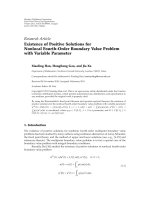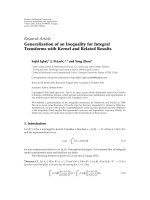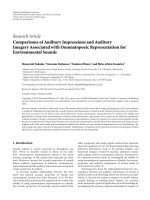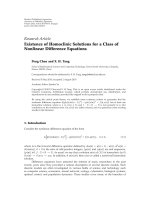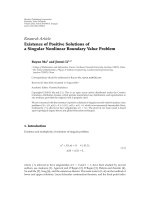Báo cáo hóa học: " Research Article Properties of Positive Solution for Nonlocal Reaction-Diffusion Equation with Nonlocal Boundary" potx
Bạn đang xem bản rút gọn của tài liệu. Xem và tải ngay bản đầy đủ của tài liệu tại đây (526.75 KB, 12 trang )
Hindawi Publishing Corporation
Boundary Value Problems
Volume 2007, Article ID 64579, 12 pages
doi:10.1155/2007/64579
Research Article
Properties of Positive Solution for Nonlocal Reaction-Diffusion
Equation with Nonlocal Boundary
Yulan Wang, Chunlai Mu, and Zhaoyin Xiang
Received 21 January 2007; Accepted 11 April 2007
Recommended by Robert Finn
This paper considers the properties of positive solutions for a nonlocal equation with
nonlocal boundary condition u(x, t)
=
Ω
f (x, y)u(y,t)dy on ∂Ω × (0,T). The conditions
on the existence and nonexistence of global positive solutions are given. Moreover, we
establish the u niform blow-up estimates for the blow-up solution.
Copyright © 2007 Yulan Wang et al. This is an open access article distributed under the
Creative Commons Attribution License, which permits unrestricted use, distribution,
and reproduction in any medium, provided the original work is properly cited.
1. Introduction
In this paper, we consider the following nonlocal equation with nonlocal boundary con-
dition:
u
t
= Δu +
Ω
u
q
(y,t)dy− ku
p
, x ∈ Ω, t>0,
u(x,t)
=
Ω
f (x, y)u(y,t)dy, x ∈ ∂Ω, t>0,
u(x,0)
= u
0
(x), x ∈ Ω,
(1.1)
where p,q
≥ 1, k>0, and Ω ⊂ R
N
is a bounded domain with smooth boundary. The
function f (x, y)
≡ 0 is nonnegative, continuous, and defined for x ∈ ∂Ω, y ∈ Ω, while u
0
is a nonnegative continuous function and satisfies the compatibility condition u
0
(x) =
Ω
f (x, y)u
0
(y)dy for x ∈ ∂Ω.
Many physical phenomena were formulated into nonlocal mathematical models (see
[1–3]) and studied by many authors. And in recent few years, the reaction-diffusion
equation with nonlocal source has been studied extensively. In particular, M. Wang and
2 Boundary Value Problems
Y. Wang [4] studied the heat equation with nonlocal source and local damping term
u
t
− Δu =
Ω
u
q
(y,t)dy− ku
p
, (1.2)
which is subjected to homogeneous Dirichlet boundary condition. They concluded that
the blowup occurs for large initial data if q>p
≥ 1 while all solutions exist globally if
1
≤ q<p.Incaseofp = q, the issue depends on the comparison of |Ω| and k. Using
the Green’s function, they also proved the blowup set is
Ω.In[3], Souplet introduced
a new method for investigating the rate and profile of blowup of solutions of diffusion
equations with nonlocal reaction terms. He obtained the uniform blow-up rate and blow-
up profile for large classes of equations. Particularly, for problem (1.2)withhomogeneous
Dirichlet boundar y condition, Souplet [3] obtained the following blow-up estimate when
q>p
≥ 1:
lim
t→T
(T − t)
1/(q−1)
u(x,t) = lim
t→T
(T − t)
1/(q−1)
u(t)
∞
=
(q − 1)|Ω|
−1/(q−1)
, (1.3)
where T is the blow-up time of u(x,t). For q
= p>1, Souplet [5]gavetheblow-uprate
as
lim
t→T
(T − t)
1/(q−1)
u(x,t) = lim
t→T
(T − t)
1/(q−1)
u(t)
∞
=
(q − 1)
|
Ω|−k
−1/(q−1)
. (1.4)
On the other hand, parabolic equations with nonlocal boundary conditions are also
encountered in other physical applications. For example, in the s tudy of the heat con-
duction within linear thermoelasticity, Day [6, 7] investigated a heat equation subject
to a nonlocal boundar y condition. Friedman [8] generalized Day’s result to a parabolic
equation
u
t
= Δu +g(x,u), x ∈ Ω, t>0, (1.5)
which is subject to the following boundary condition:
u(x,t)
=
Ω
f (x, y)u(y,t)dy. (1.6)
He established the global existence of solution and discussed its monotonic decay prop-
erty, and then proved that max
Ω
|u(x, t)|≤ke
−γt
under some hypotheses on f (x, y)and
g(x,u). Some further results are also obtained on problem (1.5) coupled with boundary
condition (1.6) (see [9–11]) later.
Nonlocal problems coupled w ith nonlocal b oundary condition, such as ( 1.6), to our
knowledge, has not been well studied. Recently, Lin and Liu [12] studied a parabolic
equation with nonlocal source
u
t
= Δu +
Ω
g(u)dx, x ∈ Ω, t>0, (1.7)
which is subject to boundary condition (1.6). The authors considered the global existence
and nonexistence of solutions. Moreover, the y derived the blow-up estimate for some
special g(u).
Yulan Wang et al. 3
For other works on nonlocal problems, we refer readers to [1, 3, 13–21] and references
therein.
The main purpose of this paper is to investigate problem with nonlocal source and
nonlocal boundary, which is a combination of the work of [4] and that of [6–8, 12]. Pre-
cisely, we are interested in the combined effect of the nonlocal nonlinear term
Ω
u
q
(y,
t)dy, the damping term and the nonlocal boundary upon the behavior of the solution of
problem (1.1). We will give the conditions of existence and nonexistence of global solu-
tion for (1.1), and establish the precise estimate of the blow-up rate under some suitable
hypotheses. Due to the appearance of the kernel f (x, y), the blow-up conditions will be
some different from those of above works.
In order to state our results, we introduce some useful symbols. Throughout this paper,
we let λ and φ be the first eigenvalue and the corresponding normalized eigenfunction of
the problem
−Δφ(x) = λφ, x ∈ Ω; φ(x) = 0, x ∈ ∂Ω. (1.8)
Then λ>0,
Ω
φ(x)dx = 1.
Our main results could be stated as followed. Firstly, for the global existence and finite
time blow-up condition, we have the following theorems.
Theorem 1.1. If 1
≤ q<p,allsolutionsofproblem(1.1)existglobally.
Theorem 1.2. If q>p
≥ 1,problem(1.1) has solutions blowing up in a finite time as well
as global solutions. Precisely,
(i) if
Ω
f (x, y) ≤ 1 and u
0
(x) ≤ (k/|Ω|)
1/(q−p)
, then the solution exists globally;
(ii) if
Ω
f (x, y) > 1 and u
0
(x) > (k/(|Ω|−k))
1/q
, (|Ω| >k), then the solution blows up
in finite time;
(iii) for any f (x, y)
≥ 0,thereexistsa
2
> 0 such that the solution blows up in finite time
provided that u
0
(x) >a
2
φ(x).
Theorem 1.3. Suppose p
= q>1.Forany f (x, y) ≥ 0,thesolutionblowsupinfinitetime
when u
0
(x) is large enough. If
Ω
f (x, y)dy <1, the solution exists globally when u
0
(x) ≤
a
1
ψ(x) for some a
1
> 0 (where ψ(x) is defined in (3.8)).
Remark 1.4. When p
= q = 1, it is obvious that the problem has no blow-up solution.
For the blow-up rate estimate, we could derive the following results in the case of
Ω
f (x, y)dy ≤ 1.
Theorem 1.5. Let q>p
≥ 1 and
Ω
f (x, y)dy ≤ 1.Ifu is the solution of (1.1) which blows
up at finite time T, then
lim
t→T
(T − t)
1/(q−1)
u(x,t) = lim
t→T
(T − t)
1/(q−1)
u(t)
∞
=
(q − 1)|Ω|
−1/(q−1)
(1.9)
uniformly on compact subsets of Ω.
In the case of q
= p, the sharp blow-up rate is affected by the presence of the local
damping term.
4 Boundary Value Problems
Theorem 1.6. Let q
= p>1 and
Ω
f (x, y)dy ≤ 1.If0 <k<|Ω| and u is the solution of
(1.1)whichblowsupatfinitetimeT, the n
lim
t→T
(T − t)
1/(q−1)
u(x,t) = lim
t→T
(T − t)
1/(q−1)
u(t)
∞
=
(q − 1)
|
Ω|−k
−1/(q−1)
(1.10)
uniformly on compact subsets of Ω.
Remark 1.7. Theorems 1.5 and 1.6 imply that the blow-up set of a blow-up solution is
Ω.
Remark 1.8. Comparing the results of Theorems 1.5-1.6 with (1.3)and(1.4), we find
that in the case of
Ω
f (x, y)dy ≤ 1, the o ccurrence of the kernel function f (x, y) do not
change the blow-up rate.
The rest of this paper is organized as follows. In Section 2, we give the comparison
principle and the local existence of a positive solution. Using sub- and supersolution
methods, we will give the proof of Theorems 1.1–1.3 in Section 3. Finally, we establish
the uniform blow-up rate estimate and prove Theorems 1.5 and 1.6 in Section 4.
2. Comparison principal and local existence
Let Ω
T
= Ω × (0, T)andΩ
T
∪ Γ
T
= Ω × [0, T). We begin with the definition of subsolu-
tion and supersolution of (1.1).
Definit ion 2.1. A function u
(x, t)iscalledasubsolutionof(1.1)onΩ
T
if u ∈ C
2,1
(Ω
T
) ∩
C(Ω
T
∪ Γ
T
) satisfies
u
t
≤ Δu +
Ω
u
q
(y,t)dy− ku
p
, x ∈ Ω, t>0,
u
(x, t) ≤
Ω
f (x, y)u(y,t)dy, x ∈ ∂Ω, t>0,
u
(x,0) ≤ u
0
(x), x ∈ Ω.
(2.1)
A supersolution is defined analogously with each inequality reversed.
Proposition 2.2. Let u and v be a nonnegat ive subsolution and supersolution, respectively,
with u(x,0) <v(x,0) for x
∈ Ω.Then,u<vin Ω
T
.
To prove this comparison principle, we need the following lemma.
Lemma 2.3. Suppose that w(x,t)
∈ C
2,1
(Ω
T
) ∩C(Ω
T
∪ Γ
T
) satisfies
w
t
− Δw ≥ c
1
(x, t)w +
Ω
c
2
(y,t)w(y,t)dy, x ∈ Ω, t>0,
w(x, t)
≥
Ω
c
3
(x, y)w(y,t)dy, x ∈ ∂Ω, t>0,
(2.2)
where c
1
, c
2
, c
3
are bounded functions and c
2
(x, t) ≥ 0 in Ω
T
, c
3
(x, y) ≥ 0 for x ∈ ∂Ω, y ∈ Ω
andisnotidenticallyzero.Thenw(x,0) > 0 for x
∈ Ω implies w(x,t) > 0 in Ω
T
.
Yulan Wang et al. 5
Proof. Set θ(x,t)
= e
λt
w(x, t), λ ≥ sup|c
1
|,then
θ
t
≥ Δθ +
λ +c
1
θ +
Ω
c
2
(y,t)θ(y,t)dy,
θ(x,t)
∂Ω
≥
Ω
c
3
(x, y)θ(y,t)dy,
θ(x,0) > 0, x
∈ Ω.
(2.3)
Since θ(x,0) > 0forallx
∈ Ω, by continuity, there exists a t
0
> 0suchthatθ(x, t) > 0
for (x,t)
∈ Ω
t
0
. Suppose that t
1
(t
0
≤ t
1
<T) is the first time at which θ has a zero for
some x
0
∈ Ω.LetG(x, y;t) denote the Green’s function for Lu = u
t
− Δu with boundary
condition u
= 0, x ∈ ∂Ω, t>0. Then for y ∈ ∂Ω, G(x, y;t) = 0and(∂G/∂n)(x, y;t) ≤ 0;
θ(x,t)
≥
Ω
G(x, y;t)θ(y,0)dy+
t
0
Ω
G(x, y;t − η)
λ +c
1
(y,η)
θ(y,η)dydη
+
t
0
Ω
c
2
(x
,η)θ(x
,t)dx
Ω
G(x, y;t − η)dydη
−
t
0
∂Ω
∂G
∂n
(x, ξ;t
− η)
Ω
c
3
(ξ, y)θ(y,η)dydξdη.
(2.4)
Since θ(x,t) > 0forallx
∈ Ω,0<t<t
1
, we find that
θ
x, t
1
≥
Ω
G(x, y;t)θ(y,0)dy>0. (2.5)
In particular, θ(x
0
,t
1
) > 0, which contradicts our assumption.
Remark 2.4. If
Ω
c
3
(x, y)dy ≤ 1, w(x,0) ≥ 0 implies that w(x,t) ≥ 0inΩ
T
. In this case, for
any δ>0, θ(x, t)
= e
λt
w(x, t)+δ
satisfies all inequalities in (2.3). Therefore, w + δ>0
for any δ, and it follows that w(x,t)
≥ 0.
Using Lemma 2.3,wecouldproveProposition 2.2 easily.
Local in time existence and uniqueness of classical solutions of (1.1) could be obtained
by using the representation formula and the contraction mapping principle as in [9].
We omit the standard argument here. From Proposition 2.2, we know that the classical
solution is positive when u
0
(x) is positive. We assume that u
0
(x) > 0 in the rest of the
paper.
3. Global existence and blowup in finite time
In this section, we will use super- and subsolution techniques to derive some conditions
on the existence or nonexistence of global solution.
Proof of Theorem 1.1. Remember that λ and φ be the first eigenvalue and the correspond-
ing normalized eigenfunction of
−Δ with homogeneous Dirichlet boundary condition.
6 Boundary Value Problems
We choose l to satisfy that for some 0 <ε<1,
M
Ω
1
lφ(y)+ε
≤ 1, (3.1)
where M
= sup
y∈Ω,x∈∂Ω
f (x, y). Let
v(x, t)
=
ce
γt
lφ(x)+ε
, (3.2)
where
c
= max
sup
Ω
u
0
(x)+1
lφ(x)+ε
,sup
Ω
(lφ + ε)
p
k
Ω
1
(lφ + ε)
q
dy
1/(p−q)
,
γ
≥ λ +sup
Ω
2l
2
|∇φ|
2
(lφ + ε)
2
.
(3.3)
Then we have
v
t
− Δv −
Ω
v
q
dy+ kv
p
= γv − v
λlφ
lφ + ε
+
2l
2
|∇φ|
2
(lφ + ε)
2
−
c
q
e
qγt
Ω
1
(lφ + ε)
q
dy+ kc
p
e
γpt
1
(lφ + ε)
p
≥ 0,
v(x,0) >u
0
(x) .
(3.4)
On the other hand, for any x
∈ ∂Ω,wehave
v(x, t)
=
ce
γt
ε
>ce
γt
≥
Ω
ce
γt
lφ(y)+ε
f (x, y)dy
=
Ω
f (x, y)v(y,t)dy. (3.5)
Therefore, v(x,t)isasupersolutionof(1.1) and the solution u(x,t) <v(x,t)by
Proposition 2.2. Therefore, u(x,t) exists globally.
Proof of Theorem 1.2. (i) Let v(x,t) = (k/|Ω|)
1/(q−p)
. It is easy to see that v(x,t)isasu-
persolution of (1.1)if
Ω
f (x, y) ≤ 1andu
0
(x) ≤ (k/|Ω|)
1/(q−p)
.ByProposition 2.2,the
solution u(x,t) exists globally.
(ii) Consider the following problem:
v
(t) =|Ω|v
q
− kv
p
, v(0) = v
0
. (3.6)
As q>p, v
p
≤ v
q
+1.Fromthen|Ω|v
q
− kv
p
≥ (|Ω|−k)v
q
− k.
Therefore, the solution of (3.6) is a supersolution of the following equation:
v
(t) =
|
Ω|−k
v
q
− k, v(0) = v
0
. (3.7)
When
|Ω| >kand q>1, it is known that the solution to this equation blows up in finite
time if v
0
> (k/(|Ω|−k))
1/q
.
Yulan Wang et al. 7
Obviously, the solution of problem (3.6)isasubsolutionofproblem(1.1)when
Ω
f (x,
y)dy >1andu
0
(x) >v
0
. By comparison principle, u(x,t) is a blow-up solution.
(iii) Notice that u(x,t) > 0whenu
0
(x) > 0. From [4, Theorem 3.4], we could obtain
our conclusion directly.
Proof of Theorem 1.3. Firstly, noticing t hat the solution to (1.2) coupled with zero bound-
ary condition blows up in finite time if the initial data is large enough (see [4,Theorem
3.3]), we obtain our blow-up result immediately.
Now, we show there exists global solutions if
Ω
f (x, y)dy <1.
Let ψ(x) b e the unique positive solution of the linear elliptic problem
−Δψ(x) = δ, x ∈ Ω;
ψ(x)
=
Ω
f (x, y)dy, x ∈ ∂Ω.
(3.8)
δ is a positive constant such that 0
≤ ψ(x) ≤ 1(as
Ω
f (x, y)dy <1, there exists such δ).
Let v(x)
= a
1
ψ(x), where a
1
> 0 is chosen such that
−Δv(x) = δa
1
>a
p
1
Ω
ψ
p
(x) dx − kψ
p
(x)
=
Ω
v
p
(x) dx − kv
p
(x) . (3.9)
For x
∈ ∂Ω, v(x) = a
1
Ω
f (x, y)dy ≥
Ω
f (x, y)v(y)dy.
By Proposition 2.2 it follows that u(x, t) exists globally provided that u
0
(x) ≤ a
1
ψ(x).
4. Uniform blow-up est i mate
In this section, we will obtain the uniform blow-up rate estimate of problem (1.1). Our
method is based on the general ideas of [3]. But technically, it is quite different due to the
difference of the boundary condition.
In the process of proving Theorem 1.5, we denote
g(t)
=
Ω
u
q
(y,t)dy, G(t) =
t
0
g(s)ds, H(t) =
t
0
G(s)ds. (4.1)
Lemma 4.1. Assume that
Ω
f (x, y)dy ≤ 1 for x ∈ ∂Ω.Letu(x,t) be the solution of (1.1).
Then
0
≤ u(x,t) ≤ C
1
+ G(t) (4.2)
in [T/2,T)
× Ω for some C
1
> 0.
Proof. Setting v
= Δu and taking the Laplacian of the first equality in (1.1)yield
v
t
− Δv =−kp
u
p−1
v +(p − 1)u
p−2
|∇u|
2
≤−
kpu
p−1
v in (0,T) × Ω. (4.3)
Therefore, by the maximum principle, v cannot achieve an interior positive maximum.
8 Boundary Value Problems
For x
∈ ∂Ω, y ∈ Ω,wehave
v(x, t)
= u
t
(x, t) −
Ω
u
q
(y,t)dy+ ku
p
=
Ω
f (x, y)u
t
(y,t)dy−
Ω
u
q
(y,t)dy+ k
Ω
f (x, y)u(y,t)dy
p
=
Ω
f (x, y)v(y,t)dy−
1 −
Ω
f (x, y)dy
g(t)
− k
Ω
f (x, y)u
p
(y,t)dy−
Ω
f (x, y)u(y,t)dy
p
.
(4.4)
As 0 <F(x) =
Ω
f (x, y)dy ≤ 1, we can apply Jensen’s inequality to obtain
Ω
f (x, y)u
p
(y,t)dy−
Ω
f (x, y)u(y,t)dy
p
≥ F(x)
Ω
f (x, y)u(y,t)
dy
F(x)
p
−
Ω
f (x, y)u(y,t)dy
p
≥ 0.
(4.5)
And this leads to v(x,t)
≤
Ω
f (x, y)v(y,t)dy− (1 −
Ω
f (x, y)dy)g(t)forx ∈ ∂Ω, y ∈ Ω.
We first consider the case 0 <
Ω
f (x, y)dy < 1. If v(x,t) achieves nonnegative maxi-
mum at x
0
∈ ∂Ω in this case, then
v
x
0
,t
≤−
g(t) ≤ 0. (4.6)
If
Ω
f (x, y)dy = 1, then v(x,t) necessarily achieves nonnegative maximum at t = 0. In
fact, if v(x, t) achieves nonnegative maximum at x
0
∈ ∂Ω in this case, we have v(x
0
,t) ≤
Ω
f (x
0
, y)v(y,t)dy.Ifv(x,t) is a constant, we obtain our result directly, or else, there
exists an Ω
1
⊂⊂ Ω such that x
0
∈ Ω
1
and v(x,t) <v(x
0
,t) for arbitrary x = x
0
, x ∈ Ω
1
.
Then,
Ω
f (x, y)v(y,t)dy =
Ω
1
f (x, y)v(y,t)dy+
Ω\Ω
1
f (x, y)v(y,t)dy
<v
x
0
,t
Ω
1
f (x, y)+
Ω\Ω
1
f (x, y)v(y,t)dy
≤ v
x
0
,t
Ω
1
f (x, y)+v
x
0
,t
Ω\Ω
1
f (x, y)dy
= v
x
0
,t
.
(4.7)
This is a contradiction.
So, Δu is bounded above.
Integrating the first equation in (1.1)betweenT/2andt
∈ (T/2,T), we obtain 0 ≤
u(x,t) ≤ C
1
+ G(t).
Yulan Wang et al. 9
Lemma 4.2. Assume that q>p
≥ 1 and
Ω
f (x, y)dy ≤ 1 for x ∈ ∂Ω.Letu(x,t) be the
solution of (1.1). Then
sup
x∈K
ρ
G(t) −u(x,t)
≤
C
2
ρ
n+1
1+H(t)+M(t)
(4.8)
in [T/2,T) × Ω for some C
2
> 0;whereK
ρ
={y ∈ Ω, dist(y,∂Ω) ≥ ρ}, M(t) = o(G(t)),as
t
→ T.
Proof. Let β(t)
=
Ω
(G(t) −u(x,t))φ(y)dy,then
β
(t) =
Ω
g(t) − u
t
φ(y)dy
= λ
Ω
u(y,t)φ(y)dy+
∂Ω
u ·
∂φ
∂n
dS+ k
Ω
u
p
(y,t)φ(y)dy
≤ λ
Ω
u(y,t)φ(y)dy+ k
Ω
u
p
(y,t)φ(y)dy
=−λβ(t)+λG(t)+k
Ω
u
p
(y,t)φ(y)dy,
(4.9)
which yields
β(t)
≤ C
1+H(t)+
t
0
Ω
u
p
(y,s)dyds
. (4.10)
As q>p
≥ 1, H
¨
older’s inequality implies that
t
0
Ω
u
p
(y,s)dyds≤
t
0
Ω
u
q
(y,s)dyds
p/q
T|Ω|
1−p/q
≡ M(t) = o
G(t)
, (4.11)
as t
→ T. T his yields β(t) ≤ C(1 +H(t)+M(t)).
Similar to [3, Lemma 4.5], we can obtain sup
x∈K
ρ
[G(t) −u(x,t)] ≤ (C/ρ
n+1
)(1 +H(t)+
M(t)), in [T/2,T)
× Ω for some C>0, where K
ρ
={y ∈ Ω, dist(y,∂Ω) ≥ ρ}.
Henceforth, we could obtain the following.
Proposition 4.3. Suppose that q>p>= 1 and
Ω
f (x, y)dy ≤ 1. Then
lim
t→T
sup
Ω
u(·,t)
=∞
(4.12)
if and only if
T
0
g(s)ds =∞. (4.13)
10 Boundary Value Problems
Furthermore, if (4.12)or(4.13) is fulfilled, then
lim
t→T
u(x,t)
G(t)
= lim
t→T
u(t)
∞
G(t)
= 1 (4.14)
uniformly on compact subsets of Ω.
Using Lemmas 4.1 and 4.2,theproofofProposition 4.3 is trivial modification of [3,
Lemma 4.5 and Theorem 4.1]. So we omit it here.
By Proposition 4.3 we can prove our Theorem 1.5. The proof is due to Souplet, his
method in [3] works for this problem. We present it here for completeness and signifi-
cance.
Proof of Theorem 1.5. From (4.14), we know
u
q
(x, t) ∼ G
q
(t), t −→ T. (4.15)
By Lebesgue’s dominated convergence theorem we obtain that
Ω
u
q
(y,t)dy ∼ |Ω|G
q
(t) t −→ T. (4.16)
Hence
G
(t) = g(t) ∼ |Ω|G
q
(t),
G
1−q
(t) ∼ −(q − 1)|Ω|. (4.17)
Therefore,
G(t)
∼
(q − 1)|Ω|(T − t)
−1/(q−1)
. (4.18)
From (4.14), that is
u(x,t)
∼
(q − 1)|Ω|(T − t)
−1/(q−1)
,ast −→ T. (4.19)
We complete our proof.
Proof of Theorem 1.6. We denote g
0
(t) =
Ω
u
q
(y,t)dy, U(t) =|u(t)|
∞
= max
x∈Ω
u(x,t),
g(t)
= g
0
(t) −kU
q
(t), G(t) =
t
0
g(s)ds, H(t) =
t
0
G(s)ds.
Then, similar to Proposition 4.3,wecanobtain
lim
t→T
u(t)
∞
G(t)
= lim
t→T
u(x,t)
G(t)
= 1 (4.20)
Yulan Wang et al. 11
uniformly on compact subsets of Ω. Therefore, similar to the proof of Theorem 1.5,we
could conclude that
G
(t) = g(t) ∼
|
Ω|−k
G
q
(t), as t −→ T. (4.21)
Then, the blow-up estimate comes from (4.21).
Acknowledgments
This work is supported in part by NNSF of China (10571126) and in par t by Program
for New Century Excellent Talents in University, and by the Youth Foundation of Science
and Technology of UESTC.
References
[1] C.V.Pao,Nonlinear Parabolic and Elliptic Equations, P lenum Press, New York, NY, USA, 1992.
[2] P. Souplet, “Blow-up in nonlocal reaction-diffusion equations,” SIAM Journal on Mathematical
Analysis, vol. 29, no. 6, pp. 1301–1334, 1998.
[3] P. Souplet, “Uniform blow-up profiles and boundary behavior for diffusion equations with non-
local nonlinear source,” Journal of Differential Equations, vol. 153, no. 2, pp. 374–406, 1999.
[4] M. Wang and Y. Wang, “Properties of positive solutions for non-local reaction-diffusion prob-
lems,” Mathematical Methods in the Applied Sciences, vol. 19, no. 14, pp. 1141–1156, 1996.
[5] P. Souplet, “Uniform blow-up profile and boundary behaviour for a non-local reaction-
diffusion equation with critical damping,” Mathematical Methods in the Applied Sciences, vol. 27,
no. 15, pp. 1819–1829, 2004.
[6] W. A. Day, “A decreasing property of solutions of parabolic equations with applications to ther-
moelasticity,” Quarterly of Applied Mathematics, vol. 40, no. 4, pp. 468–475, 1983.
[7] W. A. Day, Heat Conduction within Linear Thermoelast icity, vol. 30 of Spr inger Tracts in Natural
Philosophy, Springer, New York, NY, USA, 1985.
[8] A. Friedman, “Monotonic decay of solutions of parabolic equations with nonlocal boundary
conditions,” Quarterly of Applied Mathematics, vol. 44, no. 3, pp. 401–407, 1986.
[9] K. Deng, “Comparison principle for some nonlocal problems,” Quarterly of Applied Mathemat-
ics, vol. 50, no. 3, pp. 517–522, 1992.
[10] S. Seo, “Blowup of solutions to heat equations with nonlocal boundary conditions,” Kobe Jour nal
of Mathematics, vol. 13, no. 2, pp. 123–132, 1996.
[11] S. Seo, “Global existence and decreasing property of boundary values of solutions to parabolic
equations with nonlocal boundary conditions,” Pacific Journal of Mathemati cs, vol. 193, no. 1,
pp. 219–226, 2000.
[12] Z. Lin and Y. Liu, “Uniform blowup profiles for diffusion equations with nonlocal source and
nonlocal boundary,” Acta Mathematica Scientia. Series B, vol. 24, no. 3, pp. 443–450, 2004.
[13] D. E. Carlson, “Linear thermoelasticity,” in Encyclopedia of Physics, vol. vIa/2, p. 319, Springer,
Berlin, Germany, 1972.
[14] C. V. Pao, “Dynamics of reaction-diffusion equations with nonlocal boundary conditions,”
Quarterly of Applied Mathematics, vol. 53, no. 1, pp. 173–186, 1995.
[15] C. V. Pao, “Asymptotic behavior of solutions of reaction-diffusion equations with nonlocal
boundary conditions,” Journal of Computational and Applied Mathematics,vol.88,no.1,pp.
225–238, 1998.
[16] C. V. Pao, “Numerical solutions of reaction-diffusion equations with nonlocal boundary condi-
tions,” Journal of Computational and Applied Mathematics, vol. 136, no. 1-2, pp. 227–243, 2001.
[17] Y. Wang, C. Mu, and Z. Xiang, “Blowup of solutions to a porous medium equation with nonlocal
boundary condition,” to appear in Applied Mathematics and Computation.
12 Boundary Value Problems
[18] Z. Xiang, X. Hu, and C. Mu, “Neumann problem for reaction-diffusion systems with nonlocal
nonlinear sources,” Nonlinear Analysis, vol. 61, no. 7, pp. 1209–1224, 2005.
[19] Z. Xiang, Q. Chen, and C. Mu, “Blowup properties for several diffusion systems with localised
sources,” The ANZIAM Journal, vol. 48, no. 1, pp. 37–56, 2006.
[20] H M. Yin, “On a class of parabolic equations with nonlocal boundary conditions,” Journal of
Mathematical Analysis and Applications, vol. 294, no. 2, pp. 712–728, 2004.
[21] J. Zhou, C. Mu, and Z. Li, “Blowup for degenerate and singular parabolic system with nonlocal
source,” Boundary Value Problems, vol. 2006, Article ID 21830, 19 pages, 2006.
Yulan Wang: School of Mathematics and Computer Engineering, Xihua University,
Chengdu 610039, China; Department of Mathematics, Sichuan University, Chengdu 610064, China
Email address:
Chunlai Mu: Department of Mathematics, Sichuan University, Chengdu 610064, China
Email address:
Zhaoyin Xiang: School of Applied Mathematics, University of Electronic Science and
Technology of China, Chengdu 610054, China
Email address:




